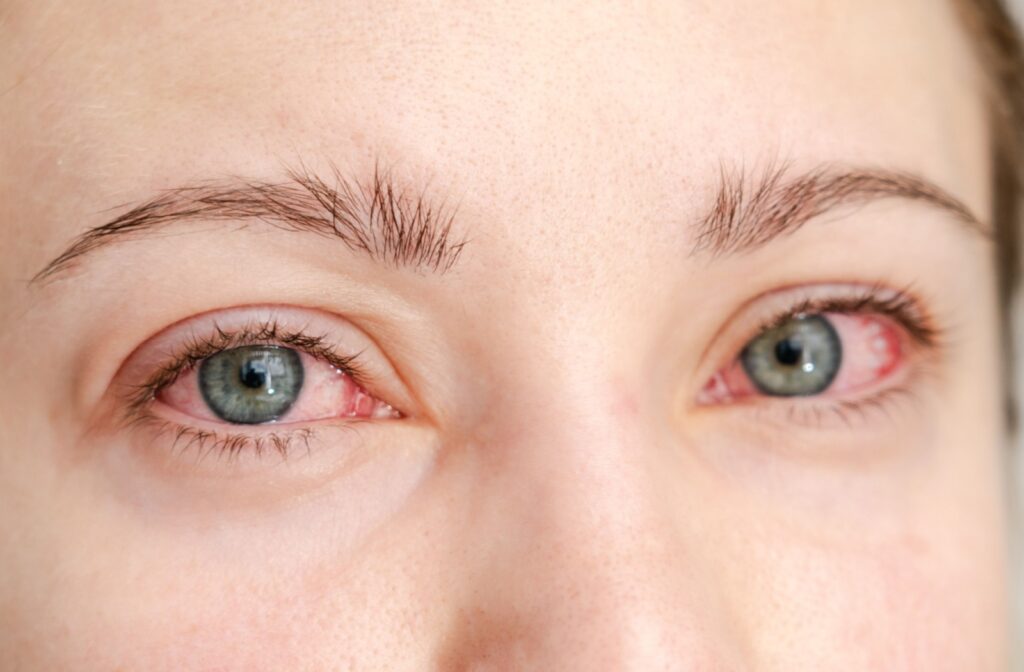Millions of people deal with irritated, watery, and swollen eyes every year. This is a tell-tale sign of allergies, and it can quickly become a significant problem. You deserve clear, comfortable vision, and you should always take any unusual symptoms seriously. So how long do eye allergies last—and how can you tell if it’s something a little more serious?
Most eye allergies resolve within a few days—especially if you manage your exposure to the initial allergens. However, this does vary depending on the severity of the reaction. If you’re ever unsure, visit your optometrist to discuss your treatment options.
What Causes Eye Allergies?
Eye allergies, also known as allergic conjunctivitis, are the immune system overreacting to certain substances called allergens. This reaction occurs when you’re exposed to dust, pet dander, mold, and other common particles. It can even be a seasonal problem as a response to higher pollen counts in the air.
When exposed to an allergen, your immune system releases histamines. These try to fight off the perceived threat but end up producing unpleasant symptoms in the process. This is why avoiding allergens whenever possible is one of the best ways to prevent allergy flare-ups.
Common Symptoms Of Eye Allergies
Eye allergies can cause a range of different symptoms. These tend to include:
- Redness in the eyes
- Itchiness or irritation
- Watery or teary eyes
- Swelling around the eyes
- Sensitivity to light
- A burning sensation
- Blurry vision
However, there is a problem with eye allergies. Other conditions, like pink eye and infections, can cause these same symptoms. If you ever notice significant pain, persistent stinging, or discolored discharge from the eyes, visit your optometrist to rule out more serious problems.
How Long Do Eye Allergies Last?
Eye allergies can vary. Sometimes, symptoms go away within a few hours, but other times, they can last for a few days. It all depends on how you manage your exposure to the initial trigger. Continuous exposure to allergens or other irritants—like smoke and strong perfumes—can make the symptoms stick around longer.
If you know what’s setting off your symptoms, take active steps to avoid it. In a high-pollen area, it helps to stay indoors and use an air purifier if possible. Wash your hands and face to remove any stubborn particles from your skin, and use cold compresses as needed to find relief.
How To Find Relief For Eye Allergies
If you’re dealing with the discomfort of eye allergies, there are plenty of ways to find relief. It’s all about managing your symptoms and minimizing potential irritants.
It helps to:
- Use over-the-counter antihistamine eye drops to reduce itching and redness.
- Apply a cool, damp cloth over your eyes to soothe irritation and swelling.
- Keep windows closed during high pollen seasons to limit allergens entering your home.
- Clean your bedding and pillowcases frequently to avoid the buildup of allergens.
- Shower nightly to remove allergens that can settle on your skin and hair during the day.
- Avoid wearing contact lenses during flare-ups to reduce irritation.
- Consult an eye care professional for prescription treatments if symptoms persist.
Taking these steps can significantly improve how you feel and help prevent future symptoms. However, if your symptoms persist or worsen, don’t ignore it. You can visit your optometrist for personalized advice and stronger treatment options.
Eye Allergies Vs. Dry Eyes: How To Tell The Difference
Allergies often cause redness, watery eyes, and irritation. But they’re not the only condition known to cause these symptoms. Dry eye disease, a common eye condition, also causes these symptoms—and it can cause significant discomfort if left untreated.
How to Recognize Allergies
Eye allergies develop in response to specific allergens, and symptoms may flare up during certain times of the year. They’re easy to manage by minimizing your exposure to the initial allergen.
Allergies tend to affect more than just the eyes, too. They can cause:
- Sneezing
- Nasal congestion
- Runny nose
- Itchy throat
- Skin irritation
If you notice these symptoms, it’s likely allergies.
How to Recognize Dry Eye Disease
On the other hand, dry eye disease develops due to a problem with tear production. If your symptoms persist for longer than a few days, it could be dry eye disease.
This condition causes:
- Stinging or burning sensations
- Redness in the eyes
- Blurred vision
- Sensitivity to light
This condition only affects the eyes. It leaves your cornea exposed to the outside air, which increases the risk of long-term vision problems. If you suspect dry eye disease is causing your symptoms, visit your optometrist to discuss dry eye therapy.
Find The Relief You Deserve
Eye allergies can be incredibly uncomfortable, but relief is possible—with the right care. Between preventive measures and over-the-counter treatments, there are plenty of ways to take control of your eye comfort.
If you’re not sure where to start, come see our team at Littlefield Eye Associates. We’re here to help you find the relief you deserve, and we offer several treatments designed to reduce your symptoms. Book an appointment with us to take the first step toward healthier, happier eyes.





